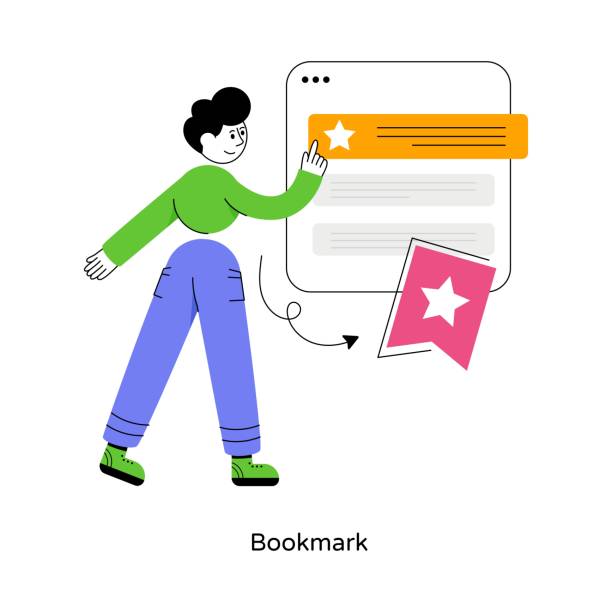Introduction to Modern UI Website Design and Its Importance

In today’s digital age, #web design and #user interface are no longer merely aesthetic aspects; they have become the backbone of #user experience and, ultimately, the success of an online business.
#Modern UI website design goes beyond a beautiful appearance; it’s a comprehensive approach that focuses on ease of use, efficiency, and user enjoyment when interacting with a website.
A modern user interface guides the user along their desired path, provides information quickly, and creates an unforgettable user experience.
The importance of this issue is such that websites lacking an attractive and user-friendly interface, even if they have excellent content, fall behind in competition with more modern sites.
This explanatory approach will help you gain a better understanding of this vital concept.
Today, users expect websites to be not only fast and responsive but also visually appealing and interactively intuitive.
Modern UI website design meets these expectations and allows businesses to establish deeper connections with their audience. In fact, user interface (UI) and user experience (UX) are inseparable elements that together determine the quality of user interaction with a digital product.
A modern user interface, utilizing minimalist design principles, simple navigation, and subtle animations, creates a user-friendly environment that is not only beautiful but also highly efficient.
This design gains double importance, especially in the current era where internet access occurs through various devices.
A website must be designed to display correctly on any screen size, from mobile to desktop, and provide a consistent experience.
This approach means #Responsive Design, which is considered one of the main pillars of modern web design.
Furthermore, a modern user interface can directly impact the #Conversion Rate.
When users can easily find what they are looking for and purchasing or registration processes are simple, the likelihood of them taking the desired actions significantly increases.
This not only leads to customer satisfaction but also ensures business profitability.
In today’s competitive world, advanced UI web design is no longer a competitive advantage; it’s a necessity. Businesses that do not invest in this area risk losing customers and market share.
In upcoming chapters, we will delve more specifically into the details and principles of this type of design and provide practical solutions for its implementation.
Falling behind in competition with large online stores?
Rasawab brings your business online with professional e-commerce website design and increases your market share!
✅ Increase brand credibility and customer trust
✅ Easy shopping experience leads to more sales
⚡ Act now to receive a free website design consultation!
Key Principles in Modern User Interface Design
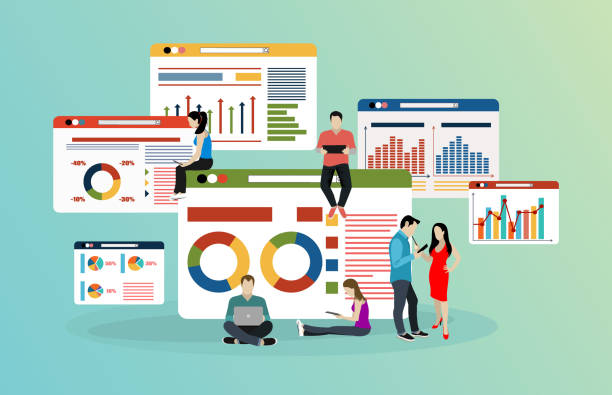
At the heart of #modern UI website design lies a set of #fundamental principles that optimize the user experience and enhance site efficiency.
One of the most important of these principles is #minimalism.
This means eliminating any superfluous elements and focusing on the core content.
By reducing visual clutter, users can quickly find the information they need and avoid unnecessary complexities.
This specialized approach helps designers focus on the essence of user interaction with the website.
The second principle is #Consistency.
All design elements, including fonts, colors, icons, and navigation patterns, should be consistent throughout the website.
This consistency makes users feel more familiar and comfortable, allowing them to navigate different pages without confusion.
A website with a modern user interface should be designed in such a way that the user quickly becomes familiar with it.
The third principle is #Feedback.
Every user interaction with the website, such as clicking a button or filling out a form, should be accompanied by visual or textual feedback.
This feedback assures the user that their operation has been successful or is being processed.
This is especially important in cases where operations are time-consuming, such as loading a page.
Displaying a progress indicator or a confirmation message prevents user confusion and uncertainty.
The fourth principle is #Intuitive Navigation.
Users should be able to find their way around the website without needing to think too much.
This means that menus should be clear, logical, and easily accessible.
Using common design patterns, such as placing the logo in the top left and the navigation menu at the top, can contribute to this intuitiveness.
#Building a website with a modern user interface requires a deep understanding of user psychology.
The fifth principle is #Accessibility.
A modern website should be usable by all users, including those with disabilities.
This includes using appropriate color contrast, the ability to change font size, support for screen readers, and providing alternative text for images.
#Optimizing web user interface for accessibility is not only an ethical imperative but can also expand your audience reach.
Adhering to these key principles will help you provide an unparalleled user experience in #modern UI website design, thereby attracting more users and gaining their satisfaction.
These principles serve as guidance for any web designer seeking to create outstanding user experiences.
The Role of User Experience (UX) in Modern Website Design
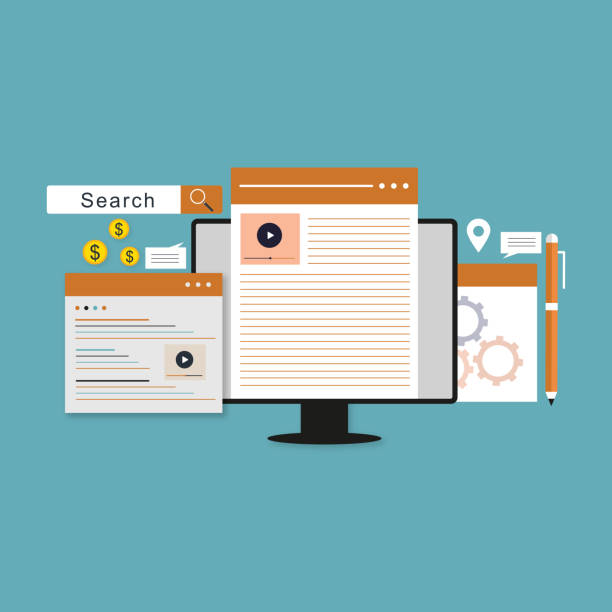
A deep understanding of #User Experience (UX) is vital for #modern UI website design.
UX goes beyond the site’s appearance and addresses the entire process of user interaction with the product, from the moment of entry to exit.
This includes the user’s feelings, attitudes, and perceptions while using the website.
The main goal of UX is to ensure that the website is not only efficient and easy to use but also enjoyable and satisfying.
This is an analytical and explanatory approach that will help you understand the complexities of this field.
Strong UX ensures that users easily achieve their goals on the site, whether it’s finding information, purchasing a product, or signing up for a service.
This requires extensive research into user needs, behaviors, and pain points.
The UX design process typically includes the following stages:
- User Research: Understanding target audiences through interviews, surveys, and behavioral data analysis.
- User Persona Creation: Developing fictional characters that represent real users and help better understand needs.
- User Flow Creation: Mapping the paths users take to achieve their goals on the site.
- Wireframing and Prototyping: Creating initial layouts and interactive samples to test ideas.
- Usability Testing: Observing real users while they interact with the prototype or final site to identify issues.
Without a strong foundation in UX, even the most beautiful user interface can lead to user frustration.
For example, a beautiful website with unclear buttons or a complicated payment process will drive users away.
In fact, modern UI website design without considering UX is like building a luxury car without a powerful engine.
The table below presents the key differences between UI and UX, which are very important in advanced UI web design:
| Feature | UI (User Interface) | UX (User Experience) |
|---|---|---|
| Definition | What the user sees and interacts with (graphical appearance) | The user’s feeling while using the product (overall experience) |
| Focus | Appearance, feel, interactivity | Usability, accessibility, value, satisfaction |
| Responsibilities | Visual design, interaction design, branding, color palette | User research, wireframing, prototyping, information architecture, usability testing |
| Tools | Sketch, Figma, Adobe XD, Photoshop | Miro, Optimal Workshop, UserTesting, Axure |
| Ultimate Goal | Creating a beautiful and functional interface | Creating a meaningful and satisfying experience |
In summary, UX plays a fundamental role in determining the success of a modern website.
#Web user interface optimization without considering user needs and behaviors will merely be a beautiful shell.
This analytical approach shows us how, through a deep understanding of users, we can create websites that are not only beautiful but also effectively respond to business goals and user needs.
It is this combination of UI and UX power that leads to success in #modern UI website design.
Modern Tools and Techniques in UI/UX Design
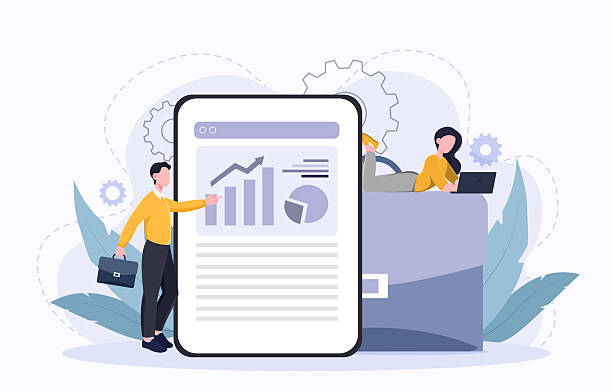
To implement #modern UI website design, designers need a set of #advanced tools and #techniques.
Choosing the right tools can make the design process simpler and more efficient.
Today, several powerful platforms help designers progress optimally from the idea stage to the final prototype.
This instructional section will help you become familiar with some of these essential tools.
One of the most popular tools currently is #Figma.
Figma is a cloud-based UI design tool that allows for real-time collaboration among designers.
This feature makes it ideal for large teams and complex projects.
Figma also possesses powerful prototyping capabilities that allow designers to realistically simulate user interactions.
This tool has become an industry standard for #building websites with a modern user interface.
#Adobe XD is another powerful option in the UI/UX design field.
This tool is part of the Adobe Creative Cloud suite and enables designers to quickly create wireframes, prototypes, and final designs.
Adobe XD, due to its integration with other Adobe products like Photoshop and Illustrator, is highly suitable for designers who use the Adobe ecosystem.
#Responsive design and #component-based techniques are well-supported in these tools.
For wireframing and information architecture, tools like #Miro and #Whimsical are also very popular.
These tools allow teams to brainstorm ideas, map user flows, and define the website’s structure before delving into visual details.
Using these tools in the early design stages can prevent wasted time and resources in later stages.
Alongside tools, #modern design techniques also play a crucial role.
#Atomic Design is a methodology that breaks down the design process into smaller, reusable components.
This approach helps designers create scalable and sustainable design systems.
Additionally, #Component-Based Design allows for the reuse of UI elements, thereby increasing development speed.
The #Mobile-First technique is also an essential approach in web user interface optimization.
This means designing first for mobile devices and then scaling it up for larger screens.
Given the significant increase in mobile usage for internet access, this approach ensures that the user experience on small devices is delivered in the best possible way.
Ultimately, mastering these tools and techniques is essential for any web designer who intends to advance in the field of #modern UI website design.
This specialized knowledge enables the creation of websites that are not only visually stunning but also effectively meet user needs.
Are you bothered by losing customers due to your e-commerce site’s outdated appearance or slow speed? Rasawab’s expert team solves these problems with professional e-commerce website design!
✅ Significantly increase customer trust and your brand’s credibility
✅ Dazzling speed and excellent user experience
Get a free consultation with Rasawab now ⚡
Current and Future Trends in User Interface Design
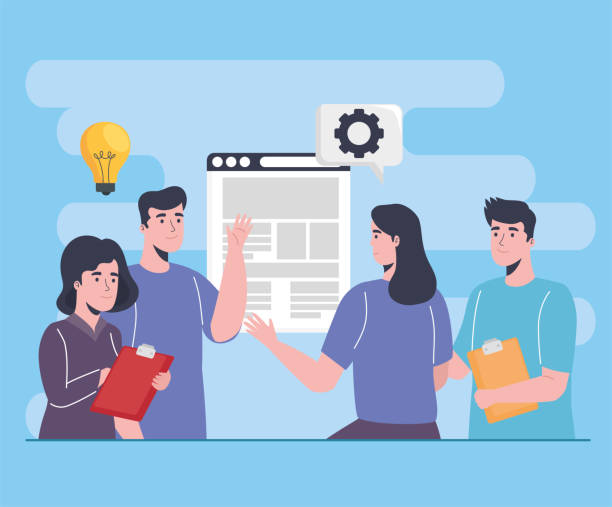
The world of #modern UI website design is constantly evolving, and with the emergence of new technologies and changing user expectations, new trends appear.
Awareness of these #current trends and anticipating #future trends is crucial for designers and businesses to remain competitive and offer more engaging user experiences.
This news and analytical section provides you with a comprehensive view of what is happening now and in the near future in UI design.
One of the most important current trends is #Dark Mode design.
Many users prefer to use a dark-themed interface, which is both easier on the eyes and saves battery consumption on OLED devices.
Offering a dark mode option to users demonstrates attention to personal preferences and provides a flexible experience.
Also, #minimalist design and #Whitespace continue to maintain their popularity.
Focusing on simplicity, removing extra elements, and smart use of empty space allows content to shine and creates a more soothing visual experience.
Subtle animations and #Micro-interactions also play an increasing role in #advanced UI web design.
These small animations, such as a button changing color on hover or an appealing loading animation, provide visual feedback to the user and make the experience more enjoyable.
These small details can make a big difference in the user’s overall feeling of the site and make the website appear more dynamic and lively.
In the future, #Artificial Intelligence (AI) and #Machine Learning (ML) are expected to play a more prominent role in user interface design.
These technologies can help personalize the user experience in real-time, tailor content based on user preferences, and even dynamically change UI layouts.
For example, websites might be able to automatically adjust their user interface based on the time of day, the user’s geographical location, or even their mood.
Virtual Reality (VR) and Augmented Reality (AR) also have great potential to change the face of #modern UI website design.
Imagine being able to walk through a 3D online store or view products in your real space with AR.
These technologies can offer immersive experiences that go beyond current 2D interactions.
Also, #Voice UIs will become increasingly important with the expansion of voice assistants like Siri and Alexa, and designers must consider how to integrate these interactions into websites.
Finally, #Sustainability and ethics in design will also become important trends.
Designers must consider how their designs can have a positive impact on society and the environment, from optimizing server energy consumption to promoting responsible content.
These future trends will not only be challenging but will also open new opportunities for innovation in #building websites with modern user interfaces.
Preparing for these changes is key to success in the evolving digital world.
Challenges and Solutions in Designing Websites with Advanced User Interfaces
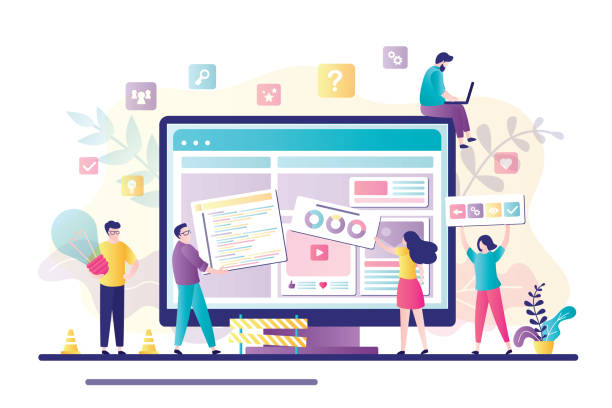
Despite all its advantages, #modern UI website design is not without its #challenges.
Designers and developers face obstacles in creating advanced user experiences that require #creative and specialized solutions.
In this section, we will examine some of these common challenges and provide practical solutions to overcome them.
One of the biggest challenges is #maintaining a balance between aesthetics and functionality.
Sometimes, designers become so engrossed in visual beauty that they sacrifice site functionality and usability.
A website may be visually stunning, but if users cannot easily interact with it, it will ultimately fail.
The #solution to this challenge is a user-centered approach that focuses on user needs and behaviors from the outset. Conducting frequent usability tests and gathering feedback from real users can help maintain this balance.
Additionally, embracing the idea that “Less is More” and using minimalist and simple design can prevent visual overload and provide a better user experience.
Another challenge is #supporting various devices and diverse browsers.
With smartphones of different screen sizes, tablets, laptops, and desktops, ensuring that the website displays correctly and provides a consistent experience across all these devices is complex.
The #solution here is to use #Responsive Design and #Mobile-First.
This approach ensures that your site is optimized for the smallest screens and then scalable for larger sizes.
Furthermore, testing the site on different browsers (such as Chrome, Firefox, Safari, Edge) and various devices is essential to ensure full compatibility.
This aspect of advanced UI web design requires meticulous attention.
The third challenge is #managing a high volume of information and complexities on large sites.
Websites with a lot of content or complex functionalities can quickly overwhelm users.
The #solution for this issue is strong #Information Architecture and #clear navigation.
Logically organizing content, using clear labels, and creating an intuitive sitemap helps users easily find what they need.
Additionally, using powerful internal search and appropriate filters can improve the user experience.
Finally, #keeping design up-to-date and in sync with new trends, is a continuous challenge.
The web world is rapidly changing, and what is modern today may be outdated tomorrow.
The #solution is for designers and development teams to be constantly learning, attending conferences and webinars, and utilizing online resources to keep their knowledge current.
Investing in continuous education and experimenting with new technologies is key to long-term success.
By addressing these challenges and implementing these specialized solutions, one can effectively achieve #building modern and efficient websites with modern user interfaces.
Case Study of Successful User Interface Design

To better understand how to successfully implement #modern UI website design, examining #case studies of successful websites and platforms can be very illuminating.
This analytical and specialized section shows you how leading companies, by utilizing UI/UX principles, have managed to provide unparalleled user experiences and, consequently, achieve remarkable success.
One of the best examples in the field of advanced UI web design is the #Airbnb platform.
Airbnb revolutionized the accommodation rental industry by offering a clean, intuitive, and image-rich user interface.
From the outset, the user experience on this site focused on simplicity, transparency, and trust.
Easy search functionality, precise filters, and the display of complete and clear information for each property help users quickly and confidently find their desired accommodation.
The step-by-step booking system and continuous visual feedback have made the process easy and enjoyable for the user.
Their responsive design also ensures that the user experience is consistent and optimized across all devices.
Another successful example is #Spotify.
This music streaming service has attracted millions of users with a dark, organized, and personalized user interface.
Spotify’s design focuses on easy navigation, new music discovery, and creating personal playlists.
The use of dark colors with bright accent points allows the content to stand out well.
Their AI-powered music recommendation algorithms are seamlessly integrated into the UI to provide a unique and personalized experience for each user.
This example demonstrates the power of #web user interface optimization in delivering personalized content.
The third case is #Slack.
Slack is a team communication platform known for its clean, efficient, and organized user interface.
Its design focuses on simplicity, searchability, and organizing conversations into different channels.
Its interface is quickly learnable for new users and presents complex communication tools in a simple and accessible format.
This example shows how a #modern UI website design can make complex tools user-friendly and increase productivity.
The table below provides a summary of the successful UI/UX features of these platforms for better understanding:
| Platform | Key UI Features | UX Strengths |
|---|---|---|
| Airbnb | High-quality images, clear search filters, step-by-step booking flow | Simplicity in searching and booking, increased trust through information transparency, responsive experience |
| Spotify | Dark mode, content organization (lists, albums), use of accent colors | Easy music discovery, strong personalization, intuitive navigation, immersive experience |
| Slack | Clean space, organized channels, use of clear icons | Efficient team communication, quick learning, powerful search capability, reduced clutter |
These case studies show us how attention to detail, a deep understanding of users, and the implementation of user-centered design principles can lead to the creation of digital products that are not only beautiful but also highly efficient and successful.
These examples are inspiring and provide practical guidance for anyone who intends to embark on #building websites with a modern user interface.
The Impact of Modern User Interface on SEO and Conversion Rate

In today’s competitive world, #modern UI website design is not limited to visual aesthetics; it is a critical factor in improving your website’s #SEO and increasing its #Conversion Rate.
A strong User Interface (UI) and User Experience (UX) directly impact how your site ranks in search engines, as well as your ability to convert visitors into customers.
This analytical section shows you how these two aspects are interconnected.
From an SEO perspective, search engines like Google increasingly value factors related to user experience.
Factors such as #site loading speed, #responsiveness (correct display on different devices), #navigation simplicity, and #user dwell time on the site are all considered positive signals for SEO ranking.
A website with a modern user interface typically loads faster, adapts well to various devices, and offers easy navigation, all of which contribute to improving your ranking in search results.
#Advanced UI web design is attractive not only to users but also to search engine bots.
Furthermore, the Bounce Rate, which indicates the percentage of visitors who leave your site after viewing only one page, is also strongly influenced by UI/UX.
A complex or unappealing user interface can lead to a high bounce rate, which is a negative signal for search engines.
In contrast, a #modern UI website design that is visually attractive and interactively intuitive encourages users to stay on the site longer and view more pages, which sends positive signals to search engines and helps improve SEO.
In terms of conversion rate, the impact of a modern user interface is even clearer.
The conversion rate is the percentage of visitors who take your desired actions, such as purchasing a product, filling out a form, or signing up for a newsletter.
Good UX makes the process of achieving these goals as easy and friction-free as possible for the user.
For example, designing a simple and clear payment form on a modern website can significantly increase the purchase completion rate.
A modern user interface, by using appropriate visual hierarchy, clear and prominent Calls to Action, and minimizing distractions, guides users towards desired actions.
It also increases brand trust and credibility.
Users are more likely to interact with websites that look professional and modern.
This trust directly leads to an increase in conversion rates.
Investing in #web user interface optimization is effectively an investment in your business’s profitability.
Ultimately, combining excellent UI/UX with quality content and strong SEO is a winning strategy for any online business looking to maximize its returns from its web presence.
This combination helps #build modern UI websites and increases their visibility.
Are you bothered by losing customers due to your e-commerce site’s outdated appearance or slow speed? Rasawab’s expert team solves these problems with professional e-commerce website design!
✅ Significantly increase customer trust and your brand’s credibility
✅ Dazzling speed and excellent user experience
Get a free consultation with Rasawab now ⚡
How to Become a Modern User Interface Designer?

Becoming a #modern User Interface (UI) designer and specialist in #modern UI website design requires a combination of theoretical knowledge, practical skills, and a creative perspective.
This high-yield and exciting career path offers many opportunities for individuals looking to create impactful digital experiences.
This instructional and guidance section answers your question on how you can progress in this field and become a successful UI/UX designer.
The first step is #learning the fundamental principles of UI/UX.
This includes understanding concepts such as color theory, typography, visual hierarchy, grid systems, and user experience principles (such as usability, accessibility, and user psychology).
Numerous online resources, including courses, books, and articles from reputable websites like Nielsen Norman Group or Interaction Design Foundation, can assist you in this area.
Continuous education and study are essential for mastering #advanced UI web design.
The second step is #mastering design tools.
As mentioned earlier, tools like Figma, Adobe XD, and Sketch are very popular for UI/UX design.
Choosing one or two tools and consistently practicing with them until achieving full proficiency is crucial.
Learning how to create wireframes, prototypes, and reusable components will strengthen your skills.
The third step is #building a strong Portfolio.
Your portfolio is your most important tool for showcasing your skills and abilities to potential employers or clients.
Start by designing personal projects, redesigning existing websites, or collaborating on hypothetical projects.
Each project should include an explanation of your design process, the challenges you faced, and the solutions you provided.
Demonstrating your thought process behind each design in #building websites with a modern user interface is very important.
The fourth step is #networking and getting feedback.
Be active in online and offline design communities.
Connect with other designers, share your work, and ask for their feedback.
Attending workshops, webinars, and conferences can also help you stay up-to-date with the latest trends and establish professional connections.
Platforms like Dribbble, Behance, and LinkedIn are excellent for this purpose.
Finally, #continuous practice and keeping your knowledge up-to-date are of paramount importance.
The world of UI/UX design is constantly changing, and successful designers are those who are always learning and adapting to new changes.
Pay attention to the latest trends, new tools, and emerging technologies.
Try daily design challenges and always look for ways to improve your skills.
This approach will help you always be at the forefront of #web user interface optimization.
Remember that success in this field doesn’t happen overnight.
With perseverance, passion, and a willingness to continuously learn, you can become a skilled modern UI designer and play a role in #modern UI website design, creating digital experiences that users truly love.
Summary and a Look at the Future of Web Design with Modern User Interface

Throughout this article, we examined various aspects of #modern UI website design and found that this field goes beyond mere aesthetics.
#Modern user interface design is, in fact, the pillar upon which an excellent #user experience is built, directly impacting the success of an online business, its SEO, and conversion rate.
From key principles to tools and future trends, every aspect of this field emphasizes the importance of a deep understanding of user needs and providing an unparalleled experience.
This explanatory and engaging section summarizes the discussions and looks at the horizons ahead.
We learned that minimalism, consistency, feedback, intuitive navigation, and accessibility are the main pillars of a modern user interface.
We also understood the vital role of User Experience (UX) in ensuring user satisfaction and loyalty.
Tools like Figma and Adobe XD enable designers to turn their ideas into reality, and techniques like responsive design and Mobile-First ensure compatibility with all types of devices.
Furthermore, emerging trends such as dark mode, artificial intelligence, and augmented reality shape the future landscape of advanced UI web design.
The future of #modern UI website design will be heavily influenced by technological advancements and changing user expectations.
With the emergence of technologies like Web 3.0, the metaverse, and further advancements in AI, user interfaces will become more interactive, personalized, and even immersive.
Imagine websites that can automatically adapt to your mood, or virtual shopping experiences where you can view products in a 3D space.
These are just some of the exciting potentials for the future.
Also, the importance of ethics and sustainability in design will become more prominent than ever.
Designers must consider how they can create websites that are not only visually and functionally excellent but also environmentally and socially responsible.
This could include optimizing for lower energy consumption or designing to create more inclusive experiences for everyone.
This responsibility will play a significant role in #building websites with a modern user interface.
For those working in this field or intending to enter it, continuous learning, curiosity, and a willingness to experiment with new technologies will be key to success.
#Modern UI website design is a dynamic discipline that never stops.
There are always new things to learn and explore, and this makes it one of the most engaging and rewarding areas of design in the digital world.
With a smart approach and an eye towards the future, one can create websites that not only meet today’s needs but are also ready for tomorrow’s challenges and opportunities.
It is hoped that this comprehensive article has provided valuable insights into #web user interface optimization.
Frequently Asked Questions
| Row | Question | Answer |
|---|---|---|
| 1 | What does Modern UI in website design mean? | Modern UI means designing websites with a minimal appearance, extensive use of white space, clear typography, vibrant colors or unified palettes, subtle animations, and a focus on visual and intuitive User Experience (UX). |
| 2 | What features make a user interface “modern”? | Key features include responsive design, smooth animations, use of vectors and SVG icons, prominent typography, sufficient white space, creative layering, appropriate colors, and a focus on accessibility. |
| 3 | What is the importance of Responsive Design in modern UI? | Responsive design ensures that the website displays correctly on any device (mobile, tablet, desktop) and provides a consistent user experience, which is one of the fundamental principles of modern UI. |
| 4 | Why is the use of White Space important in modern design? | White space or “negative space” helps text and other elements breathe and be distinguishable, increases readability, improves user focus on the main content, and creates a clean and professional appearance. |
| 5 | What is the role of animations and micro-interactions in modern UI? | Animations and micro-interactions make the user experience more dynamic and engaging, provide feedback to the user, improve navigation flow, and add a sense of quality and polish to the design. |
| 6 | What is the place of typography in modern website design? | Typography plays a very important role in modern design; appropriate fonts, size, weight, and correct spacing improve readability and can impart a specific mood and personality to the brand. |
| 7 | How can visual consistency be achieved in modern design? | By using a Design System, a limited and defined color palette, consistent typography, reusable UI components, and maintaining uniformity in spacing between elements and visual rhythm. |
| 8 | How is User Experience (UX) related to modern User Interface (UI)? | User Interface (UI) is the visual and interactive part of a product, while User Experience (UX) relates to the user’s overall feeling when using the product. A modern UI should help improve UX and be functional and intuitive beyond visual beauty. |
| 9 | What are some common trends in modern UI design? | Trends include Dark Mode, Neumorphism, Glassmorphism, large and prominent typography, use of gradients, 3D images, and Lottie animations. |
| 10 | What are the main challenges in modern UI website design? | Challenges include maintaining simplicity while innovating, ensuring accessibility, optimizing loading speed despite heavy animations and images, and balancing aesthetics and functionality. |
And other services of Rasawab Advertising Agency in the field of advertising
Smart Social Media: Transform online growth with user experience customization.
Smart Direct Marketing: Designed for businesses seeking digital branding through user experience customization.
Smart Advertising Campaign: Designed for businesses looking to manage campaigns through attractive UI design.
Smart Advertorial: An effective tool for increasing click-through rates with smart data analysis.
Smart Digital Branding: An exclusive service for customer acquisition growth based on precise target audience segmentation.
And over a hundred other services in the field of internet advertising, advertising consultation, and organizational solutions
Internet Advertising | Advertising Strategy | Advertorial
Sources
Modern Website Design PrinciplesWhat is UI/UX Design?Success Strategies in Digital BusinessWhy Do Businesses Need a Website?
? Do you want your business to shine in the digital world? Rasawab Afarin Digital Marketing Agency, by providing innovative solutions and targeted strategies, helps you establish a powerful online presence. From SEO and search engine optimization to online advertising management and user-friendly website design, we are committed to your growth and success. With Rasawab Afarin, secure the future of your business in the digital space.
📍 Tehran, Mirdamad Street, next to Bank Markazi, Kazerun Jonubi Alley, Ramin Alley No. 6

